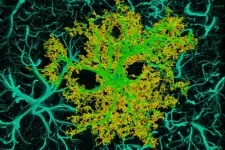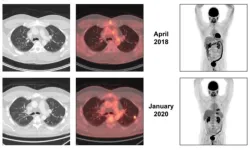(Press-News.org) In women living with HIV, preventive treatment with DHA-PPQ is a safe and effective strategy to prevent malaria during pregnancy, according to the final results of MAMAH, a clinical trial funded by the European & Developing Countries Clinical Trials Partnership (EDCTP) and coordinated by the Barcelona Institute for Global Health (ISGlobal), an institution supported by “la Caixa” Foundation. The study, published in the Lancet Infectious Diseases, could help protect the health of the estimated one million pregnant women who suffer from a double infection with malaria and HIV every year.
Pregnant women are particularly vulnerable to malaria infection. Hence the recommendation to offer preventive treatment (IPTp) based on sulphadoxine and pyrimethamine (SP) to pregnant women living in malaria-endemic areas. The problem is that these drugs are incompatible with co-trimoxazole (CTX), an antibiotic given to people with HIV to prevent bacterial infections.
“This means that the population most vulnerable to malaria infection and its consequences, namely pregnant women living with HIV, are also the least protected,” explains ISGlobal researcher Raquel González, technical coordinator of the MAMAH project, led by Clara Menéndez, director of ISGlobal’s Maternal, Child and Reproductive Health Initiative.
The aim of the project was to evaluate the safety and efficacy of two other drugs: dihydroartemisinin and piperaquine (DHA-PPQ) to prevent malaria during pregnancy in women living with HIV. The research team conducted the trial in Gabon and Mozambique with more than 600 pregnant women taking CTX in addition to antiretroviral treatment for HIV. One group of pregnant women received DHA-PPQ and the other group received a placebo.
Lower risk of malaria infection and disease
Although there was no significant difference in malaria infection at the time of delivery, women in the DHA-PPQ group had a significantly lower risk of developing clinical malaria throughout pregnancy (almost eight times lower than the placebo group) and also a lower risk (almost half) of becoming infected. DHA-PPQ was effective in women taking different antiretroviral treatments. No serious side effects were observed, and DHA-PPQ had no effect on mother-to-child transmission of HIV.
"We show that preventive treatment with DHA-PPQ is effective even in low malaria transmission settings," says Gonzalez. "Adding this strategy to malaria control tools could significantly improve the health of thousands of mothers and their babies, especially in sub-Saharan Africa, a region where an estimated one million women living with HIV are infected with malaria during pregnancy every year," she adds.
“We congratulate the MAMAH team on these important results in the field of malaria research, and, in particular, in providing better health to pregnant women living with HIV in malaria-endemic areas,” says Montserrat Blázquez-Domingo, EDCTP Senior Project Officer. “This study underlines the value of collaborative research that EDCTP supports and our focus on priority infectious disease affecting sub-Saharan Africa in populations often excluded from clinical trials – such as pregnant women.”
The MAMAH study is part of the EDCTP2 Programme supported by the European Union (grant number RIA2016MC-1613-MAMAH).
Reference
González R, Nhampossa T, Mombo-Ngoma G, et al. Safety and efficacy of dihydroartemisinin-piperaquine for intermittent preventive treatment of malaria in HIV-infected pregnant women from Gabon and Mozambique: a randomised, double-blind, placebo-controlled clinical trial. Lancet Infect Dis.
END
African women living with HIV have an effective option to prevent malaria during pregnancy
The combination of two antimalarial drugs (DHA-PPQ) reduces the risk of malaria infection and disease in pregnant women on HIV treatment, according to results from the MAMAH trial
2024-01-13
ELSE PRESS RELEASES FROM THIS DATE:
The fate of novel ideas
2024-01-13
Innovation may be what drives progress in the arts, business, sciences and technology, but the novel ideas that drive innovation often face headwinds that hinder or even prevent their adoption.
Why did some good ideas, such as hand sanitizing in 19th-century hospitals or racial integration in the 20th century, take years to win widespread embrace? University of Utah postdoctoral researcher Wayne Johnson set out to identify the hurdles.
His research team’s program of five studies, which featured analyses of evaluations of films screened at Utah’s Sundance Film ...
Are bugs bugging humans or the other way around? Study reveals a few surprises
2024-01-13
Insects and spiders often receive little attention from people, except when we’re swatting them away. However, as arthropods — creatures distinguished by a hard exoskeleton and jointed legs— they play an essential role in sustaining the ecosystems humans rely on. Remarkably, arthropods make up approximately 84% of all known animal species.
A study published recently in Scientific Reports reveals how human activity affects biodiversity among arthropods and how nonbiological factors, such as daily temperature swings and proximity to the ocean, affect arthropod biodiversity in urban areas.
The research uncovered a few ...
Could an already approved drug cut down on opioid use after surgery?
2024-01-12
Researchers in the Department of Anesthesia and Perioperative Medicine at the Medical University of South Carolina (MUSC) have found that an FDA-approved drug may help to decrease pain after surgery. In the pilot study published in Pain Management, spinal surgery patients who received N-acetylcysteine (NAC) during surgery in addition to standard pain control treatments reported lower pain scores and requested fewer opioids after surgery than patients given a placebo.
Opioids are often given for a short time after ...
HOXA9 tracking reveals RBM5 dual function and therapeutic potential for acute myeloid leukemia
2024-01-12
(Memphis, Tenn – January 12th, 2024) The protein HOXA9 is overexpressed in most acute myeloid leukemia (AML) cases and is associated with poor patient outcomes. However, HOXA9 is a difficult protein to target therapeutically, so researchers at St. Jude Children’s Research Hospital looked for ways to extinguish it indirectly. Using CRISPR/Cas9 screening, the researchers identified RBM5, demonstrating a causative link between RBM5 expression and leukemia cell proliferation. This link is driven by a novel dual function of RBM5 as both a DNA and RNA handler ...
Male gender expression in schools is associated with substance abuse later in life
2024-01-12
A new study led by researchers at the University of Chicago found that changes in male gender expression from adolescence to young adulthood align closely with the gender norms present in individuals’ school environments, and that these trajectories are associated with subsequent patterns of substance abuse.
Amidst a growing consensus among social science researchers that separates gender from biological sex, gender has come to be defined as a constellation of expected behaviors, attributes, preferences and beliefs typically associated with a specific gender identity. Prior research shows that traditional models of male gender identity, constructed over time through sociocultural ...
Goldstein selected to help lead statewide task force addressing heart disease and stroke
2024-01-12
LEXINGTON, Ky. (Jan. 12, 2024) — Larry Goldstein, M.D., chair of the University of Kentucky Department of Neurology, has been selected to serve as co-chair of The Kentucky Heart Disease and Stroke Prevention (KHDSP) Task Force representing stroke systems of care across the state.
Goldstein is co-director of the Kentucky Neuroscience Institute, co-director of the UK Neuroscience Research Priority Area, contact PI for the state’s CDC Coverdell National Acute Stroke Program grant, and interim director of the UK-Norton Healthcare Stroke Care Network. Additionally, he also sits on ...
Healthy Hearts for Women event marks 10 years of raising awareness
2024-01-12
LEXINGTON, Ky. (Jan. 12, 2024) — The University of Kentucky will mark a decade of raising awareness and continuing its effort to warn women about the dangers of heart disease with the annual Healthy Hearts for Women Symposium.
Cardiovascular disease is the No. 1 killer of women, causing 1 in 3 deaths each year, according to the American Heart Association. Yet, only 44% of women recognize that cardiovascular disease is their greatest health threat.
“We see the evidence of this devastating statistic right here in Kentucky. The Commonwealth has the highest rates of deaths due to cardiovascular disease in women ...
Building trust and saving lives: A community approach to genetic education
2024-01-12
Changes to DNA, known as mutations, can increase the likelihood of developing cancer. Specifically, people with mutations in their BRCA 1 and 2 genes are substantially more likely to develop hereditary breast and ovarian cancers. But how do people know if they have these mutations?
Genetic testing.
Genetic testing allows doctors to see these microscopic changes. Knowing these mutations exist, doctors will check for signs of breast and ovarian cancers more often.
Yet minorities, especially Black women, are less likely to participate in genetic testing. ...
Using idle trucks to power the grid with clean energy
2024-01-12
University of Waterloo researchers are tapping into idled electric vehicles to act as mobile generators and help power overworked and aging electricity grids.
After analyzing energy demand on Alberta’s power grid during rush hour, the research proposes an innovative way to replenish electrical grids with power generated from fuel cells in trucks.
“Canada’s power grids need to be upgraded,” said Dr. XiaoYu Wu, lead researcher and a professor in Waterloo’s Department of Mechanical and Mechatronics Engineering.
“But the price ...
Activity of pazopanib in EWSR1-NFATC2 translocation-associated bone sarcoma
2024-01-12
“Pazopanib is a multi-kinase inhibitor that is currently approved for treatment of advanced renal cell carcinoma and chemotherapy-refractory soft tissue sarcoma.”
BUFFALO, NY- January 12, 2024 – A new case report was published in Oncoscience (Volume 10) on September 20, 2023, entitled, “Activity of pazopanib in EWSR1-NFATC2 translocation-associated bone sarcoma.”
Pazopanib, a multi-kinase VEGF inhibitor, is currently FDA approved for advanced renal cell carcinoma and advanced soft tissue sarcoma; but limited evidence exists on its efficacy in bone sarcomas.
In this case report, researchers Mohamed A. Gouda, ...
LAST 30 PRESS RELEASES:
Support for parents with infants at pediatric check-ups leads to better reading and math skills in elementary school
Kids’ behavioral health is a growing share of family health costs
Day & night: Cancer disrupts the brain’s natural rhythm
COVID-19 vaccination significantly reduces risk to pregnant women and baby
The role of vaccination in maternal and perinatal outcomes associated with COVID-19 in pregnancy
Mayo Clinic smartwatch system helps parents shorten and defuse children's severe tantrums early
Behavioral health spending spikes to 40% of all children’s health expenditures, nearly doubling in a decade
Digital cognitive behavioral treatment for generalized anxiety disorder
Expenditures for pediatric behavioral health care over time and estimated family financial burden
Air conditioning in nursing homes and mortality during extreme heat
The Alps to lose a record number of glaciers in the next decade
What makes a good proton conductor?
New science reporting guide published for journalists in Bulgaria
New international study reveals major survival gaps among children with cancer
New science reporting guide published for journalists in Turkey
Scientists develop a smarter mRNA therapy that knows which cells to target
Neuroanatomy-informed brain–machine hybrid intelligence for robust acoustic target detection
Eight SwRI hydrogen projects funded by ENERGYWERX
The Lundquist Institute and its start-up company Vitalex Biosciences Announces Strategic Advancement of Second-Generation fungal Vaccine VXV-01 through Phase 1 Trials under $40 Million Competitive Con
Fine particles in pollution are associated with early signs of autoimmune disease
Review article | Towards a Global Ground-Based Earth Observatory (GGBEO): Leveraging existing systems and networks
Penn and UMich create world’s smallest programmable, autonomous robots
Cleveland researchers launch first major study to address ‘hidden performance killer’ in athletes
To connect across politics, try saying what you oppose
Modulating key interaction prevents virus from entering cells
Project explores barriers to NHS career progression facing international medical graduates
Jeonbuk National University researchers explore the impact of different seasonings on the flavor perception of Doenjang soup
Two Keck Medicine of USC Hospitals named Leapfrog Top Teaching Hospitals
World-first discovery uncovers how glioblastoma tumours dodge chemotherapy, potentially opening the door to new treatments
A fatal mix-up: How certain gut bacteria drive multiple sclerosis
[Press-News.org] African women living with HIV have an effective option to prevent malaria during pregnancyThe combination of two antimalarial drugs (DHA-PPQ) reduces the risk of malaria infection and disease in pregnant women on HIV treatment, according to results from the MAMAH trial




